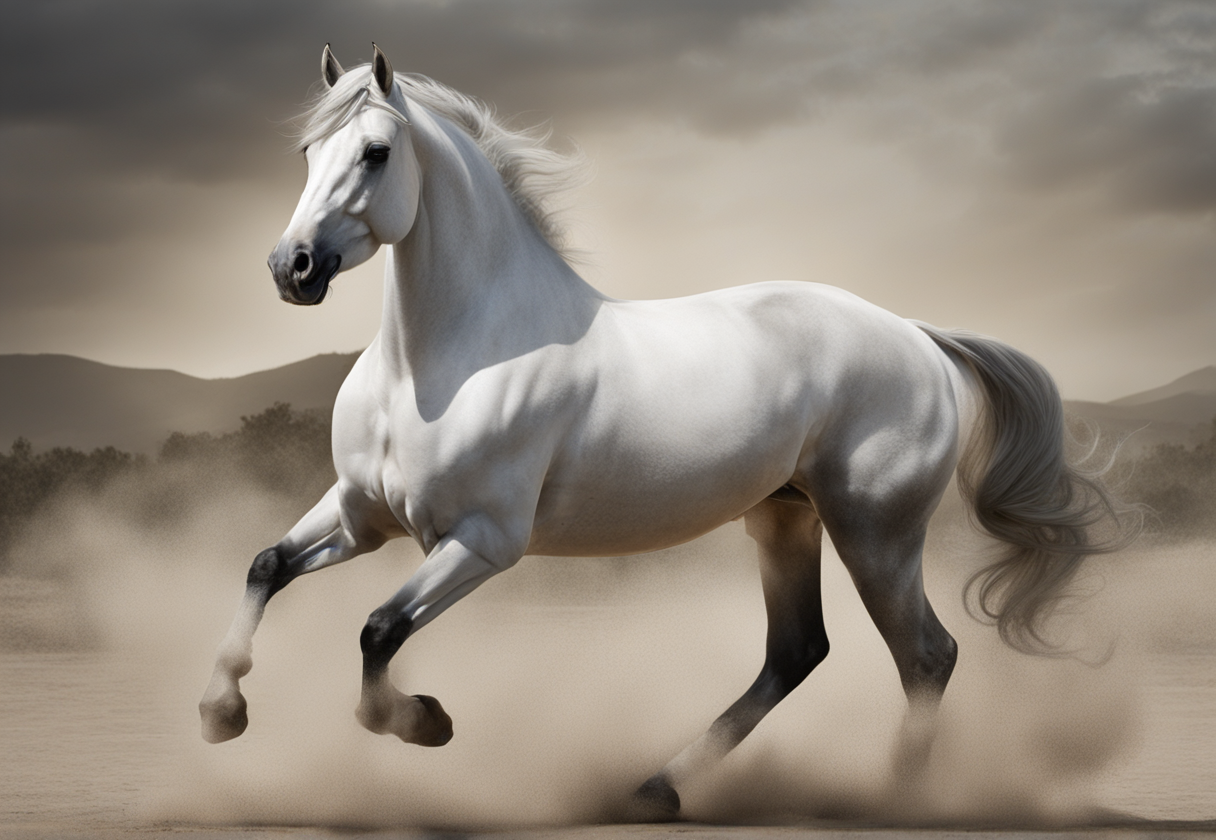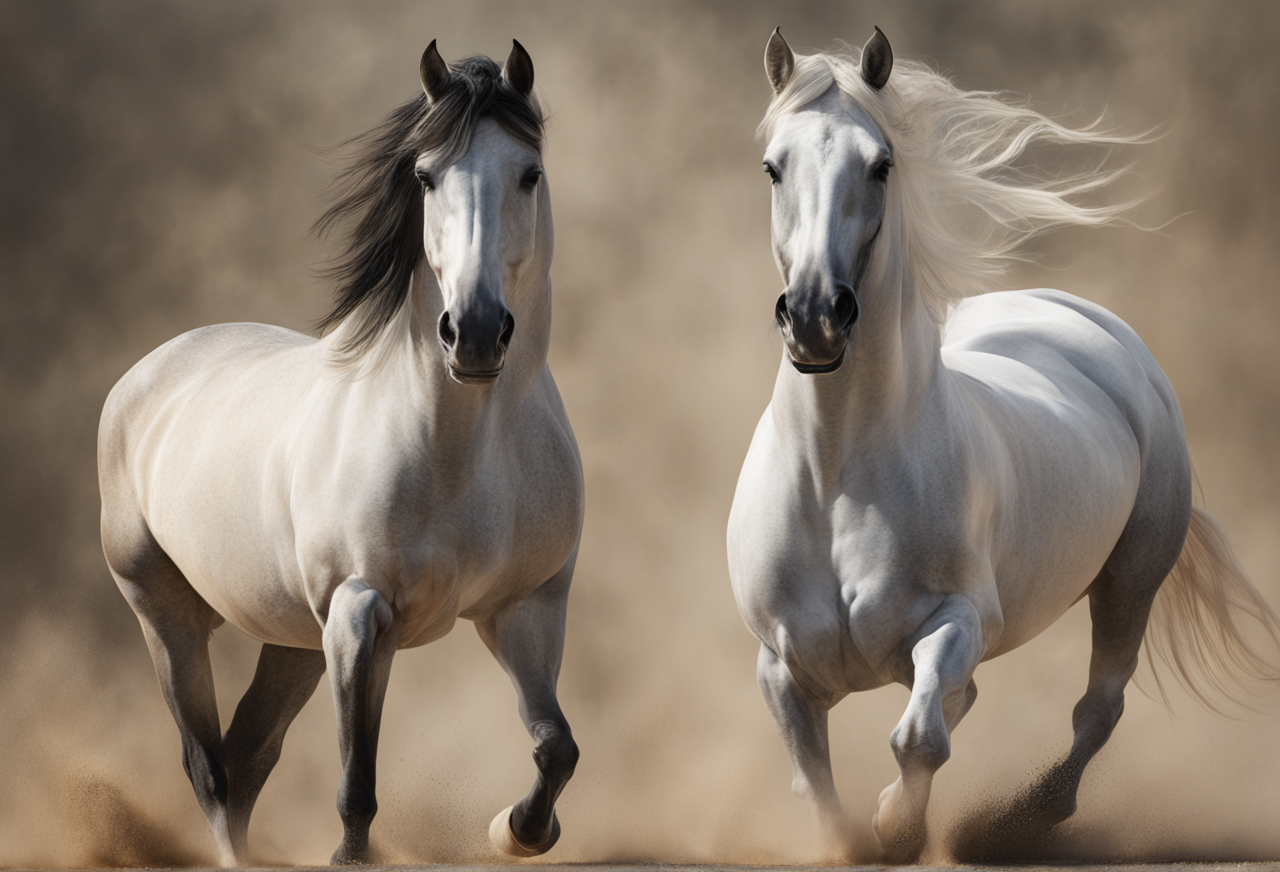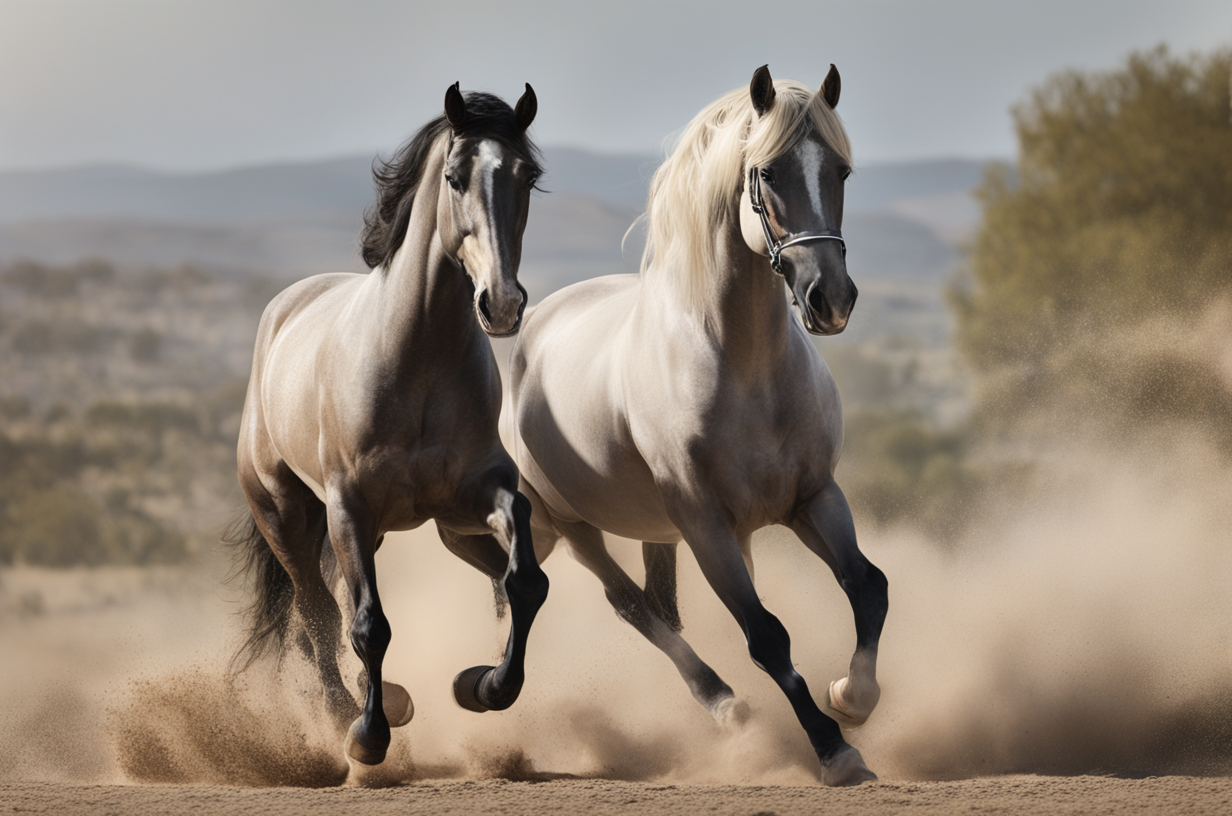I’ve had a lifelong passion for horses, ever since I was a little kid begging my parents to let me take riding lessons.
As I got older and continued riding, I became fascinated by the different horse breeds and all their unique characteristics.
Two breeds that have always intrigued me are the Andalusian and Lusitano.
Both originating from the Iberian peninsula in Spain and Portugal, these horses have similar histories yet some distinct differences.
In this post, I’ll compare these iconic breeds so you can decide which might be best for you.
The Andalusian tends to be taller and thicker-built compared to the more agile Lusitano.
A cool fact about Lusitanos – some historians believe they descend from ancient wild horses in the region over 4,000 years ago!
Table of Contents
Origins & History

Andalusians have their origins in the Spanish region of Andalusia, where they’ve been selectively bred for over 4 millennia.
References to these majestic horses date back as far as AD 50! They were the mounts of nobility and legendary war horses during the Renaissance. Andalusians were also exported for use in the development of other breeds like the Lipizzaner.
Today, Carthusian monks living in Spain maintain one of the oldest and most pure Andalusian breeding farms at their monastery, called Cartuja.
The Carthusians helped preserve and further develop Andalusian bloodlines over the past few centuries. If you get the chance to see Cartuja horses at shows in Spain, you’ll see some of the best examples of this breed.
Meanwhile, Lusitanos take their name from the ancient Roman name for the region that is now Portugal. They were developed as working horses on farms and estates, used for farmwork, bullfighting and riding. Quick and nimble, Lusitanos were perfect for maneuvering around charging bulls!
Historically, Portuguese kings, nobles and war heroes rode Lusitanos into battle. For centuries, Lusitanos were seen as symbols of power and status among Portuguese riders.
And they still are today – the president and other officials in Portugal ride this national breed in ceremonial parades.
Some historians believe Lusitanos may have ancient wild horse origins on the Iberian peninsula, tracing as far back as 4100 BC! Research suggests there was once an indigenous wild horse in the region that contributed bloodlines to today’s Lusitano breed.
How cool would it be to handle a modern horse with ancient wild horse ancestors?!
Size & Conformation
When it comes to size and build, Andalusians tend to stand taller at around 15.2 to 16 hands high, with a thicker yet still proportional frame.

Their average weight is 1000-1100 lbs. They have well defined muscling, strong necks arched for dressage, and an overall substantial presence. You can imagine them boldly carrying knights into crusades!
Lusitanos typically stand between 15 – 15.1 hands tall at the withers, with an average weight of 900-1000 lbs.
They have a lighter build than the Andalusian but are still quite strong and athletic in appearance. Their build has more finesse – they are compact horses but not bulky.
A Lusitano gives off an impression of agility rather than raw power.
So if you prefer riding a larger, stronger mount with commanding presence, the Andalusian might be your perfect match. But if you want something more compact and quick-footed, choose the Lusitano.
Movement & Gaits
When it comes to movement, both Andalusians and Lusitanos are incredible to watch in action! They carry themselves with athleticism, impulsion and racehorse-like vigor.

Andalusians are famed for their elevated, extended gaits. You’ll do a double-take as their long legs seem to float over the ground when they trot.
At Grand Prix dressage, they drive powerfully from the hindquarters and bring their knees dangerously high! An Andalusian doing movements like the capriole or courbette is an unforgettable sight.
While Lusitanos also float through their paces, they have a reputation for being extra nimble on their feet.
If you watch a Lusitano do working equitation or dressage tests requiring tight turns and quick sprints, you’ll surely be impressed! They don’t quite have the raw power of the Andalusian, but their athleticism shines through in their speed and agility.
Temperament & Personality
When it comes to temperament, both breeds score highly as willing, people-oriented partners. However, there are some subtle differences.
Andalusians often form an exceptionally close bond with their person. Seriously loyal and eager to please, they will happily put in long hours practicing dressage moves or perfecting your chosen equestrian sport. Calm and kind by nature, they seem to enjoy human companionship.
Lusitanos are also very intelligent and loving horses when well-handled. But they have more of a spirited side than their Andalusian cousins!
This likely stems from their history dealing with dangerous bulls and cattle work on Portuguese farms. Lusitanos are forward-thinking and confident because they had to think on their feet dealing with livestock.
So the Andalusian is your gentle sweetheart, while the Lusitano brings that element of boldness and verve. Both make excellent partners but the Lusitano will keep you on your toes a bit more!
Uses & Disciplines
When ridden to their potential, both Andalusians and Lusitanos excel at a wide variety of equestrian pursuits.
Andalusians are the rockstars of classical dressage and airs above the ground. Their flashy leg action, impulsion from behind, and graceful necks turn heads at upper level dressage shows.
But they aren’t one-trick ponies – you also see Andalusians jumping, doing western events like trail, reining and Western Dressage, and more. Their versatility combined with beauty and brio make them fantastic performers.
While Lusitanos compete well at dressage, they are most revered for their prowess in working equitation. Their agility and speed allow them to swiftly perform tasks like gate-opening and spear-throwing. Bullfighting on horseback also exploits the Lusitano’s quick reflexes.
Then they can turn around and gently babysit a novice rider out for a trail ride! That versatility from work to pleasure riding is a hallmark of the Lusitano horse.
I’ve also seen Lusitanos excel at show jumping and Western sports like reining and roping. So both breeds can segue between disciplines, but the Andalusian is your best bet for upper level dressage and classical riding pursuits.
Availability & Cost
One main consideration if you hope to purchase one of these breeds is availability and cost. Since the global Lusitano population is smaller than that of Andalusians, Lusitanos tend to be in lower supply. There are only around 5,000 Lusitano broodmares registered worldwide as of 2020.
With high demand but small numbers, buying a Lusitano often costs more than an Andalusian. While Andalusians range from $15,000-$60,000 on average, expect to invest $25,000-$100,000+ for a Lusitano! The expense reflects their rarity and versatile abilities.
In the U.S. there are around 30,000 total Andalusians registered while less than 4,000 Lusitanos are recorded with registries. So you’ll have an easier time tracking down an Andalusian breeder or sale horse in your region vs. finding a Lusitano option.
Training Style & Methods
When it comes to training Andalusians and Lusitanos, traditional dressage methods work exceptionally well. Both breeds are intelligent and aim to please their handlers. They require consistency, clear communication and positive reinforcement to reach their potential.
Classical dressage emphasizes rhythm, relaxation, connection, impulsion and straightness. This style complements both the Andalusian and Lusitano’s natural athleticism. Developing strength and balance as a foundation enables them to perform the Haute Ecole and Grand Prix movements they’re renowned for today.
However, it’s important not to rush training with either breed. Because they are so talented, it can be tempting to push them up the levels quickly. But their minds and bodies require time to develop correctly.
I’ve found spending 2-3 years on rhythm, suppleness and lateral movements results in a beautifully moving, injury-free horse. They should reliably carry themselves in an uphill, elevated frame before you ask highly technical moves. Mastering flying changes or the Spanish Walk is the icing on the cake after ensuring correct basics.
Both Andalusians and Lusitanos thrive on mental stimulation too. In-hand work, ground poles, trail obstacles and patterns keep their brains engaged. Treats and positive verbal praise keep them eagerly participating with a happy expression.
Breeding & Bloodlines
With Andalusians and Lusitanos alike, selecting individuals from proven bloodlines is key for a competitive sport horse or breeding prospect.
Wealthy individuals and stud farms closely guard bloodlines carrying decades of careful breeding.
For Andalusians, the Carthusian strain is legendary and considered one of the purest Spanish bloodlines still preserved today.
Cartuja horses trace directly to breeding stock raised by Spanish monks in the late 1500s. Known for their elegance, Carthusian Andalusians are in high demand but scarce supply.
A leading stud farm for Carthusians is Yeguada de la Cartuja in Spain. Their broodstock descends directly from the original monastery bloodstock. So if you secure one of their pedigree selections, you own a priceless piece of Andalusian history!
For Lusitanos, the Veiga and Coudelaria Nacional lineages are quite prominent, especially in Europe. The National Stallion Depot of Portugal controls the breeding of approved Lusitano stallions.
And they even have a waiting list for breedings years in advance, reflecting the desirability of National Stud bloodlines.
So whichever of these breeds you choose, study pedigrees! The right foundation bloodstock amplifies natural athleticism and trainability.
Breed Associations & Registries
For both Andalusians and Lusitanos, various breed organizations and registries exist to set standards, record pedigrees and sanction breeding.
Getting familiar with these entities helps you verify bloodlines and register ownership.
Here in the U.S., the Andalusian Horse Association of Australasia (AHAA) oversees breeding, events and registration.
They have member affiliates in America, Canada, Australia and New Zealand representing Andalusian owners.
Then in Europe, Spain’s Cria Caballar governs state-run breeding farms for Andalusians and other Spanish horse breeds.
For Lusitanos, key associations include the International Andalusian & Lusitano Horse Association (IALHA) in the U.S and the Portuguese Association of Breeders of Lusitano Horses (APSL) in Portugal itself. The APSL partners with breeders across Portugal to preserve selection practices and pedigree records.
Whether you’ll breed, show or just own as a pleasure mount, getting familiar with breed registries helps ensure you get a verifiable purebred.
Screen potential sale horses for membership IDs and look up their age, pedigree, owners and show records too.
Finding Breeders & Trainers
Though still rare in North America, it gets easier to locate reputable Andalusian and Lusitano breeders each year. Asking within equestrian circles or contacting breed associations gives you a starting point.
Some indicators of an ethical breeder include: horses registered properly with their stud book, high health and care standards, riding and handling horses personally, limiting yearly foal crop, and interest in placing horses sustainably.
Request to visit their farm yourself to meet the horses, assess conditions, and clarify contract terms. Good breeders aim for mutual understanding with buyers and lifelong follow up support.
Finding a qualified trainer is key too, especially if you lack experience with Iberian breeds. Classical dressage coaches suited to developing Andalusians and Lusitanos value:
– Time spent on foundations – at least 2 years before complex work
– measured progress between levels
– Tailored training for mental & physical development
– Riding skills grounded in tact and sensitivity
Such niche experts invest equally in educating both horse and human! Locating one becomes much easier once immersed in breed circles and equestrian networks.
Owning Andalusians vs Lusitanos
Deciding between Andalusian and Lusitano ownership means reflecting on your experience level, lifestyle, training goals and overall vision for your relationship with the horse.
Andalusians in general tend to be a bit easier for first time owners. Their sensitive yet forgiving nature gives you some wiggle room. But their large size requires knowledge of safe handling.
Meanwhile spirited Lusitanos demand more skill, consistency and leadership to thrive. They need an owner well-versed in setting boundaries paired with nurturing trust. When their needs are met, Lusitanos repay your care with heartwarming affection.
Either way, prepare for curious onlookers whenever you ride! Both breeds attract admirers asking about their graceful beauty wherever you go. I’ve found that sense of riding a “celebrity” horse becomes quite fun though.
Just know caring for an Andalusian or Lusitano carries greater cost and labor than owning grade horses. From specialized feeds to health testing to training expenses, you invest more across the board.
But devoting resources to properly develop an Iberian horse breeds life’s greatest equine partner.
Horsepower Showdown: Andalusian vs. Lusitano in a 20-Point Face-off!
| Andalusian Horse | Lusitano Horse | |
|---|---|---|
| Height | 15 to 16.2 hands | 15 to 16 hands |
| Weight | 1,000 to 1,200 pounds | Varies, sturdy build |
| Coat Colors | White or grey, various markings | Bay, chestnut, black, dun, various markings |
| Head and Neck Features | Straight or slightly convex profile, expressive eyes, arched neck | Distinctive convex profile, pricked ears, noble appearance |
| Ancestry | Traces back to medieval war horses | Rooted in Portuguese culture, used in bullfighting |
| Temperament | Intelligent, sensitive, versatile | Brave, agile, adaptable |
| Uses | Classical dressage, jumping, parades | Classical dressage, Portuguese equestrian events, bullfighting |
| Training | Responsive, trainable | Responsive, excels in dressage training |
| Popularity | Widely recognized and popular | Increasing popularity in competitive dressage |
| Cultural Significance | Historically connected to royalty and nobility | Integral part of Portuguese cultural events |
| Agility | Well-suited for jumping and agility exercises | Known for agility in bullfighting and dressage |
| Presence | Common in various equestrian disciplines worldwide | Deeply rooted in Portuguese traditions |
| Adaptability | Adapts well to different riding styles | Versatile, excelling in various equestrian activities |
| Performance | High performance in dressage competitions | Excel in classical dressage and Portuguese events |
| Versatility | Versatile, excelling in various equestrian disciplines | Known for versatility in different riding activities |
| Stamina | Good stamina for extended performances | Stamina suited for traditional bullfighting events |
| Riding Experience | Provides a smooth and comfortable ride | Offers a comfortable and controlled riding experience |
| Distinctive Features | Elegant appearance, expressive eyes | Noble profile, pricked ears, distinctive coat markings |
| Global Recognition | Recognized and valued globally in equestrian communities | Gaining international recognition for their unique traits |
Which is Right For You?
Choosing between an Andalusian and Lusitano really comes down to your riding discipline and preferences as an equestrian.
If you want to train in classical dressage and dance-like movements, the Andalusian may be your perfect partner.
Their athletic build, flowing gaits and people-pleasing attitude let them excel at upper level dressage or jaw-dropping exhibitions.
But if you need a compact, quick-footed horse for activities like working cattle or obstacle courses, the nimbler Lusitano is made for you.
Their inherent agility translates well to speed events too.
Either way, when you choose one of these Spanish breeds, you get an athletic, beautiful horse eager to bond with you.
Just know it takes time, patience and specialized knowledge to properly train an Iberian horse to reach its potential. If you put in the work, you’ll have an unforgettable equine partner for life!